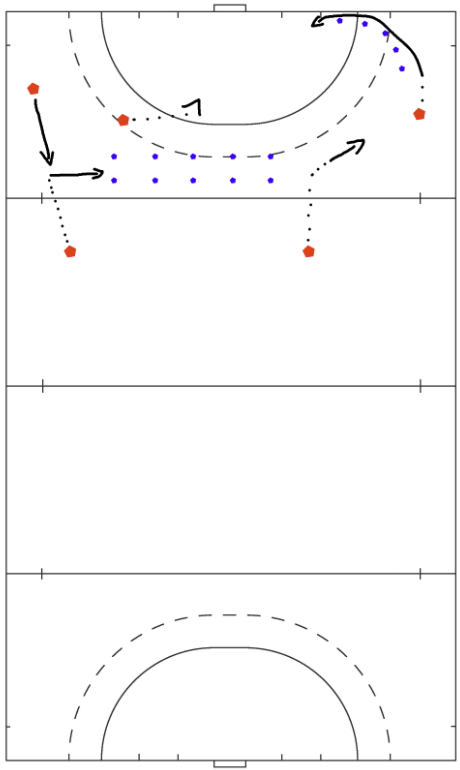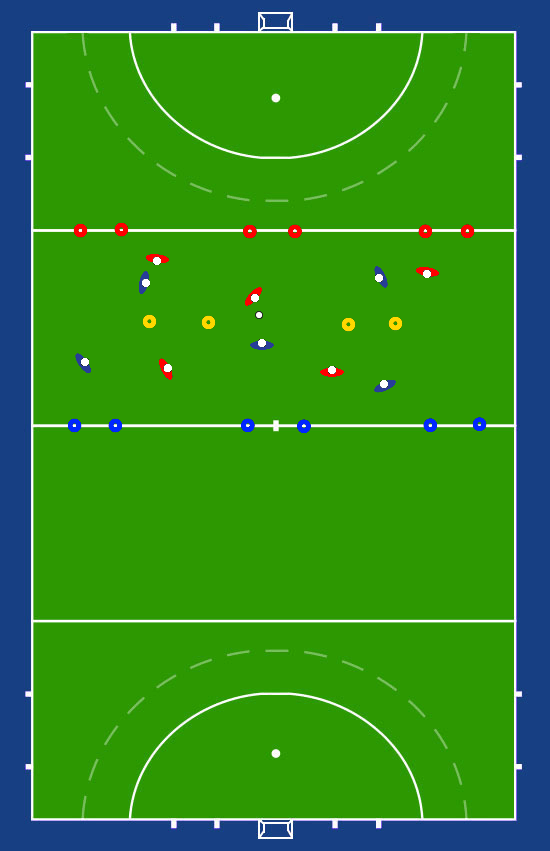Hockey drills
- 1 plays the ball using the bar to 2
2 runs in, controls the ball, moves towards the axis of the pitch and plays via the bar to 3
3 runs in, takes on and plays to the running-through number 2
2 Takes on and shoots (high) on target
Same for 4,5,6 if there are enough players for that
Press and hold 1-2-3-1 (or 1-2-3-4-5-6-1)
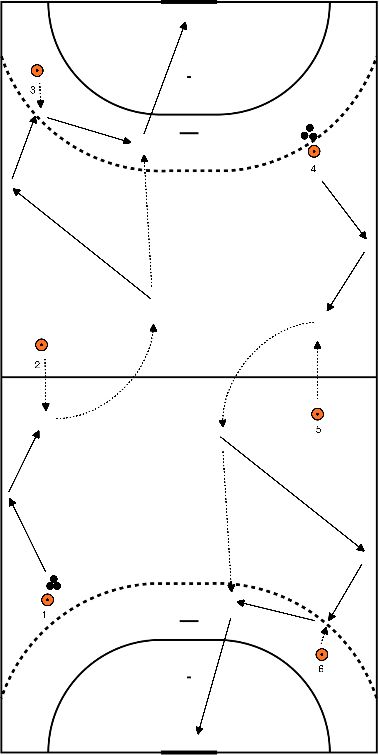
- 3 persons stand at the pilons and try not to let the player in the middle touch the ball.
- It is important that the diagonal pass is not made possible.
- So the players without the ball have to stand in the corners compared to the player with the ball.

Variation:
- Attacker plays to defender, and plays the ball back to the attacker.
- Then the attacker is allowed to attack towards goal.
- At 1, the ball begins and passes to the defender who then passes it to the out-going attacker.
- From there it is 2 to 1
- See number 2, only the players remain and it becomes a 4 against 2.
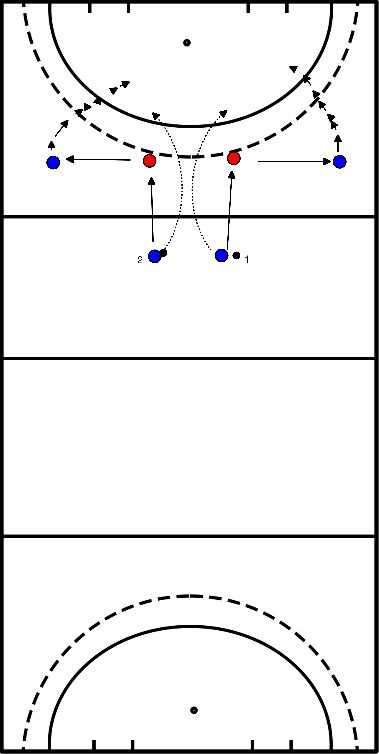
INSTRUCTIONS
- 2 teams
- 5 players per team
- 3 goals per team
- 2 yellow independent goals in the centre of the pitch
- Game: team blue against team red.
- Team red scores at one of the 3 blue pilons and team blue scores at one of the 3 red pilons.
- When the ball goes through one of the two yellow goals, the goals turn around.
- Team blue scores at the blue pilons and team red scores at the red pilons.
- When the ball goes through one of the yellow goals again, it turns around again.
AREAS OF CONCERN
Ball possession Take a good look at which of the 6 goals there's a lot of free space
Not in ball possession Trap the player with the ball from multiple sides
Game with different variations:
- with grip
- with globe
- with stick in weird position
- with other balls
- Each player takes a pilon.
- Fields of about 10x5 are made.
- The pilon is placed in the middle of the back lines.
The aim is to play past your opponent and dribble the ball over the pilon. IT IS NOT ALLOWED TO SHOOT FROM 10 METERS!
The winner goes one square to the right and the loser goes one square to the left. Rounds of -/+ 2 minutes
- A player of Blue (1) passes the ball to e.g. player 2 of Orange. This team tries to score over the 23-metre line in a yellow goal.
- Blue interferes with the defending of the Orange and tries to capture the ball and score in the normal goal. When Blue is over the 23-metre line, the team-mate at the side-line is allowed to join the game.
- Blue substitutes with Orange after 2 goals from either team.
Tips Ball possession
- Pass with good speed and direction.
- Be available (outside of the field).
- Use the hard feint pass (flats and push).
Tips Not Ball possession
- Force the player in ball possession to the side.
- Provoke making mistakes.
- Perform a quick counter after conquering ball.
Tips Counter
- Force the player in ball possession to the side.
- Provoke making mistakes.
- Perform a quick counter after conquering ball
Make it easier
- Make the field deeper (towards the center line).
Make it more difficult
- 1 extra player per team.
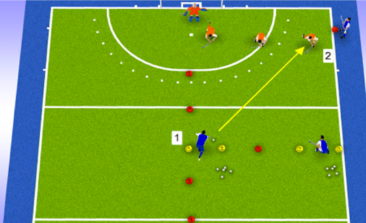
- Player 1 asks the ball in front of the pilons and receives the ball from player 3.
- At that moment player 2 grabs a ball and dribbles to the back line.
- Player 1 runs with his/her ball to the circle and finishes there.
- Then player 1 runs to the penaltyspot where he/she receives the ball from player 3.
- The ball is then finished on goal again.
- It works just like a normal game only now there's a square in the middle.
- If a shot or other foul is made, or if the ball has been out of bounds, the trainer throws/plays in a new ball from inside the square.
- The ball does not necessarily go to the same team or at the place where the foul was made.
- The size of the field depends on the number of players.
- Player 1 plays the ball to player 2 after which player 1 runs through
- Player 2 bounces the ball back to Player 1,
- Player 1 aligns the ball between the pilons (The player is not going to run into the "pilon box".)
Player 1 then finishes the ball at goal
You can speed up this exercise by placing the mirrored exercise on the other side, allowing you to play from 2 sides.
Aim:
To become physically as well as technically warm as preparation for the training.
Set up:
The exercise will be done with a maximum of 4 people. Of course you can put a multiple of these so that the exercise still works.
1. The players 1 start with the ball and play it to their players 2. Then they change positions.
2. Players 2 play the ball back to players 1 and also change positions.
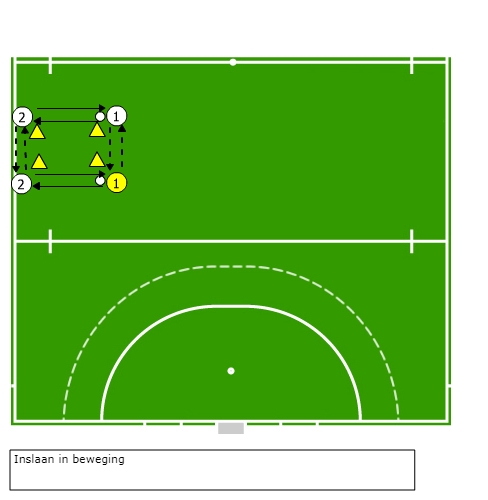
Variations:
- You can vary the way of passing (hitting, push, flats)
- Increase the distance between the pilons that players only has to run further.
- Increase the distance between the pilons that players have to pass over longer distances
- Increase both distances.
- Increase speed.
- Make as many successful passes as possible in time.
Points of attention:
- Sit low for a good control.
- Stick to the ground at ball control.
- Play the ball on the forehand side.
- Stand still while performing a ball control.
- Balls are at the first pilon.
- The player at the first pilon passes the ball to the second pilon,
- who pushes the ball through the pilons to the third person.
- The third person runs in on the ball and runs even further,
- then he pushes the ball to person 4 while he's running.
- Person 4 runs around the pilons and passes the ball at the top of the circle,
- where person 5 has just run up to finish the ball in the goal.
